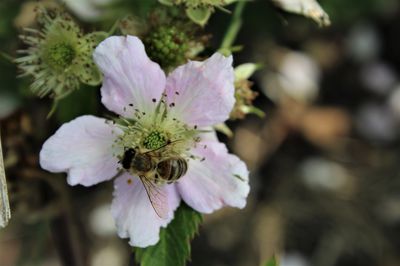 Blackberry varieties are among the most important young plant crops. With our growing assortment, which meanwhile includes more than 20 different varieties, it is easy to lose track of them. This article is intended to introduce you to our wide range of blackberry varieties and to structure them for a better overview.
Blackberry varieties are among the most important young plant crops. With our growing assortment, which meanwhile includes more than 20 different varieties, it is easy to lose track of them. This article is intended to introduce you to our wide range of blackberry varieties and to structure them for a better overview.
Thornless blackberry varieties – and the questions about aroma
The majority of varieties in our assortment are thornless varieties. The old but persistent prejudices that thornless blackberry varieties do not taste so good or are less aromatic than thorned blackberry varieties are definitely not true.
However, a few points should be taken into account when harvesting and this of course also applies to the thorned varieties. During the blackberry harvest, it is imperative to ensure that the fruits are harvested when they are really ripe because only in this condition do the varieties develop their full aromatic potential. This point of full ripeness is quite easy to recognise: if the fruit loosens from the plant during harvesting without much effort, almost by itself, then the ideal ripening time has been reached.
Upright Blackberries varieties – the Navaho® family
The innovative blackberry varieties from the Navaho® family are the ideal companion for any garden. All varieties of this group are characterised by important and basically the same characteristics:
- Total thornlessness
- A taut, upright habit, which ensures very easy training in the home garden
- Above average winter hardiness
In addition, the varieties are extremely robust and show significantly less cane losses than classic blackberry varieties, even after a strong and long winter. Especially the variety Navaho® Original has a lower susceptibility to downy mildew. And finally, all of the varieties are outstandingly aromatic and tasty.
Navaho® The Big Easy® was re-launched in spring 2019. This variety can be easily described in four words: bigger, easier, more robust. Not only are the leaves of this variety significantly larger, the flowers are noticeably bigger, sometimes quite apart from the fruits. The fruits are up to 50% larger than the variety 'Big and Early®'. But despite the large fruits, this variety is very tasty and wonderfully aromatic.
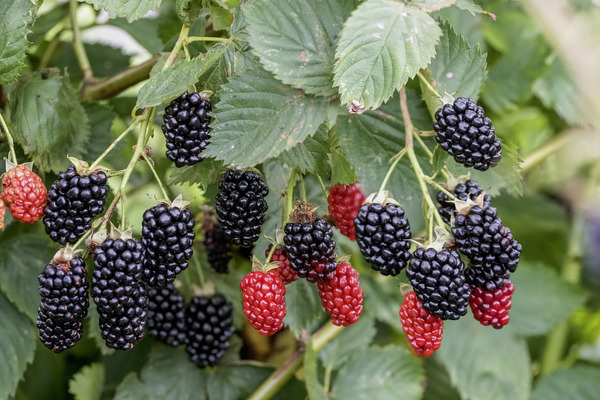
Picture: blackberry Navaho® The Big Easy®
Navaho® Big and Early® is a blackberry variety with a very early ripening period and a concentrated harvest window. The very large fruits ripen from the beginning of July and the harvest is complete already at the beginning of August. The variety is only medium strong growing with a very upright habit.
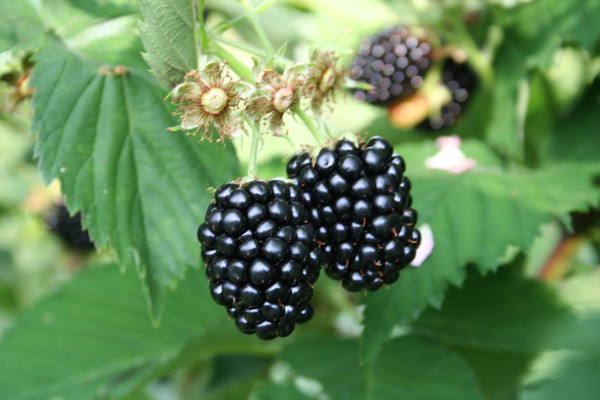
Picture: blackberry Navaho® Big and Early®
Navaho® Summerlong® is an upright blackberry variety with a long harvest window. The maturity of this variety begins in early/mid-July and extends to the end of August. This allows a very high yield of very large and aromatic fruits throughout the entire the summer.
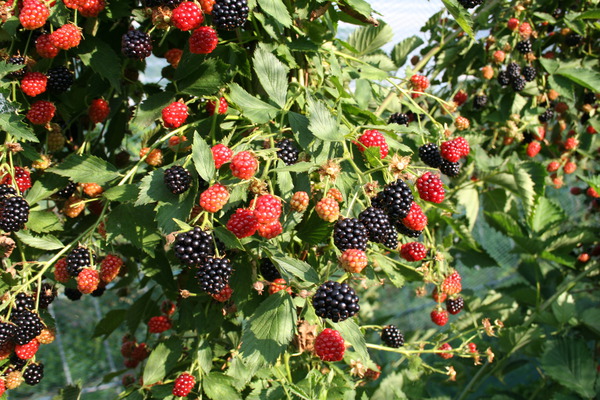
Picture: blackberry Navaho® Summerlong®
Navaho® original is the first mother of this variety group. This variety is extremely robust with a medium strong, upright habit. The aromatic fruits ripen from summer to autumn.
The classic blackberry varieties
Like the blackberry varieties from the Navaho® family, most classic blackberry varieties are completely thornless. However, these differ mainly in their growth character. Where the Navaho® varieties have a taut, upright habit, the classic varieties have the typical, arched overhanging habit, with a strong formation of tendrils.
Asterina® is a strong growing blackberry variety with very large and shiny, black fruits. The striking thing about this variety is that the fruits taste sweet before they are fully ripe. At full maturity, the sugar content is clearly superficial and there is no trace of acid at all.
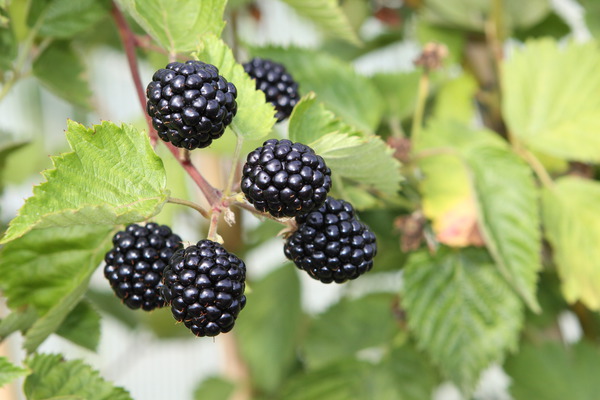
Picture: blackberry Asterina®
Loch Ness (S) is currently the leading blackberry variety in fruit production. This variety is early-maturing with a medium strong and rather upright habit. At the early start of maturity, there is a fairly long harvest window, resulting in a considerable yield. The large fruits have an attractive shine.
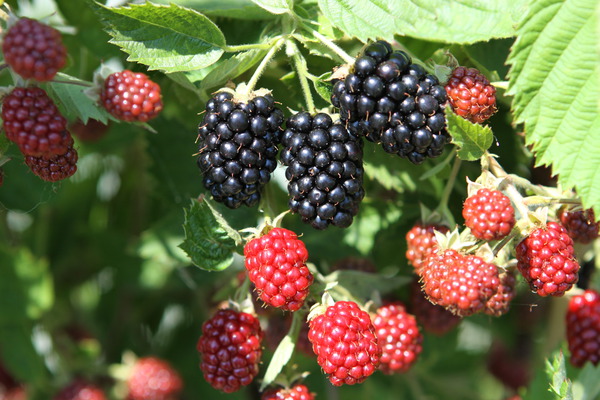
Picture: blackberry Loch Ness(S)
Triple Crown is a late maturing variety that has a strong and semi-erect habit. This variety is also extremely robust; it yields large and shiny fruits that taste juicy and sweet.
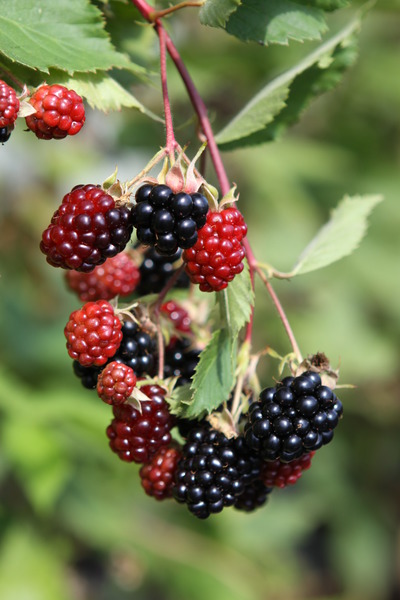
Picture: blackberry Triple Crown
Dirksens Thornless is a blackberry with a medium ripening time and a good flavour. The growth character of this vigorous growing variety is slightly arched and overhanging.
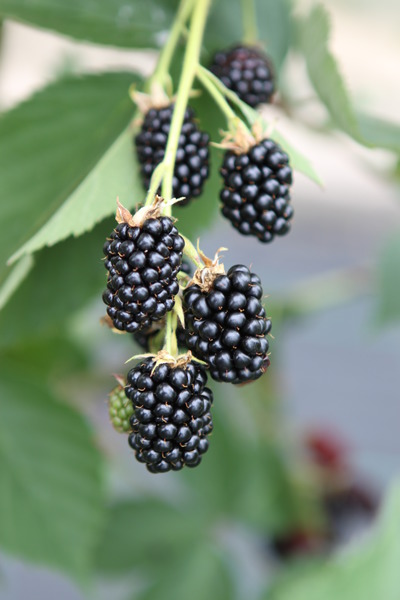
Picture: blackberry Dirksen Thornless
Black Satin is an early blackberry variety with strong growth and it produces very long canes. This variety’s large fruits are oblong-oval, shiny and black.
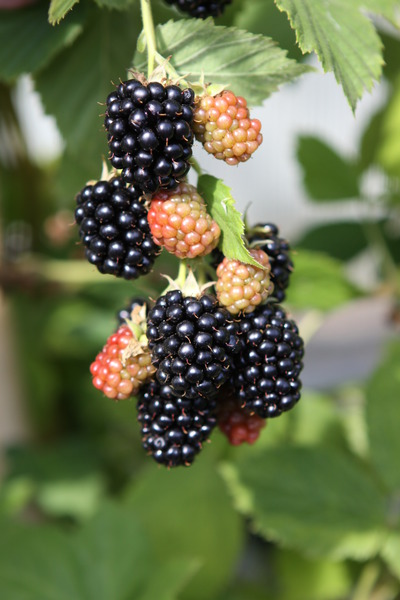
Picture: blackberry Black Satin
Thorned blackberries varieties
Some may wonder if thorned blackberry varieties still have a right to exist today. This extremely difficult question cannot be answered clearly. Although the thornless blackberry varieties have now caught up with and partly surpassed the thorned varieties in terms of taste, we have a demand for thorned blackberries. Here we rely on a well-tried classic, which is repeatedly praised as being 'biological barbed wire'.
Theodor Reimers is a very vigorous growing variety with long tendrils, which are very strongly reinforced with thorns. The medium-sized fruits ripen late and have a balanced ratio of sweetness and acidity.
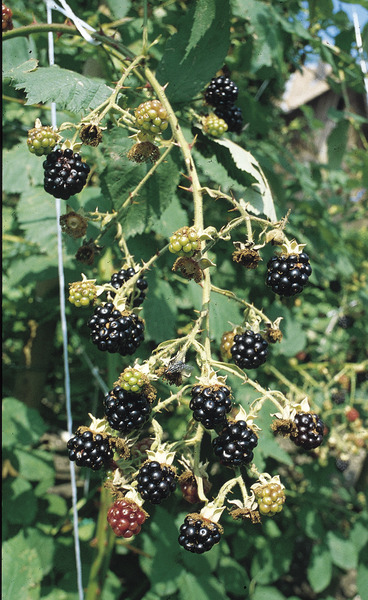
Picture: blackberry Theodor Reimers
Autumn-bearing blackberry varieties
The group of autumn-bearing or primocane fruiting blackberries is still a relatively young group of plants; the first market-relevant variety was introduced only 10 years ago. Just like it was for the autumn raspberries about 30 years ago, all beginnings are difficult. Meanwhile, the autumn blackberries are in the breeding process and it will still take a few years to bring new varieties onto the market. With the breeding successes of our sister company Lubera®, we can now also offer a wider basis of autumn-bearing blackberry varieties.
Lowberry® Little Black Prince® is the world's first compact autumn blackberry with a final height of less than 1 m. Thus, this variety is ideal as a container plant for balconies and terraces. In addition, this variety is thornless and the first fruits ripen from mid-August and produce large, shiny and tasty fruit until the first frost.
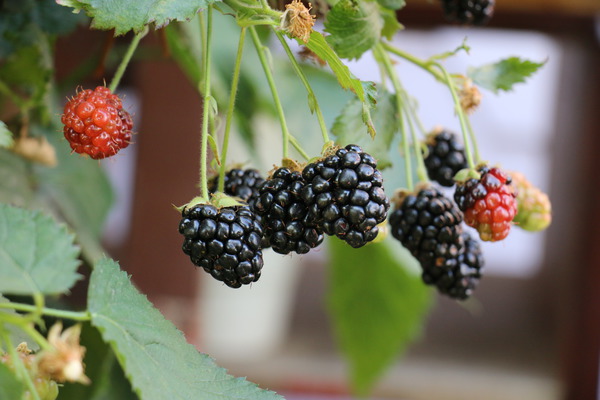
Picture: Lowberry® blackberry Little Black Prince®
Direttissima® Montblanc® is the earliest autumn blackberry in our assortment of strong growing varieties for gardens next to the compact growing Little Black Prince®. The robust canes have an upright habit and can be cut at a height of 50 cm in order to generate more shoots. The very large and aromatic fruits ripen from mid-August on the tops of the one-year-old shoots.
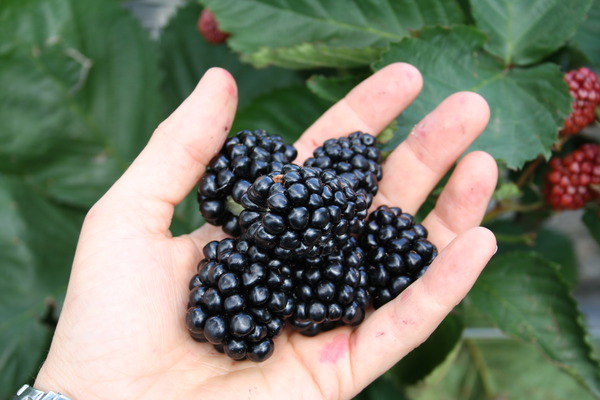
Picture: primocane blackberry Direttissima® Montblanc®
Reuben (S) was the first autumn-bearing blackberry variety on the market. The large and glossy, black fruits of this variety mature from the end of August to the beginning of September.
The special blackberry varieties
In addition to the conventional growth forms and fruit colours, there are also always blackberry specialities. On the one hand, it is noticeable, different young plants that stand out in the breeding programme and on the other hand, there are botanical varieties that are significantly different than 'normal' blackberries.
Black Cascade is a fairly compact blackberry that blooms and bears fruit on the two-year-old shoots. Its compactness makes it ideal for planting in a hanging basket. At maturity from mid/late August, the shoots hang with the medium-sized and shiny, black fruit over the edge of the hanging basket and are therefore easy to harvest.
Polarberry is a real peculiarity due to its white fruits. This is a true blackberry, but the colouring agent anthocyanin is missing. As a result, the fruits are milder in flavour and have virtually no acid, but still the typical blackberry aroma. Another positive effect is that the white fruits are less attractive to birds and the spotted wing drosophila, and there is less damage from sunburn on the fruits. Like the classic blackberries, the variety Polarberry bears fruit on the two-year-old shoots; the maturation period begins around mid-July and lasts until the beginning of September.

Picture: white fruiting blackberry Polarberry
Oregon Thornless (Thornless Evergreen) has particularly striking, slotted foliage. This variety has very vigorous growth and it forms long tendrils. The medium-sized fruits mature starting in late August and have a unique, spicy aroma.
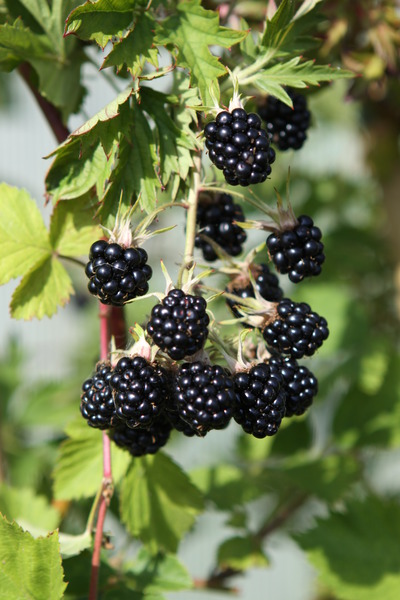
Picture: blackberry Oregon Thornless
Japanese wineberry is not a variety in the true sense but a separate species (Rubus phoenicolasius). The Japanese wineberry has strong growth and the long tendrils are reinforced with innumerable, mostly very fine thorns. From the fine pale pink flowers, a variety of small, orange-red fruits with an exceptionally exotic aroma and a slightly resinous note ripen starting in August.
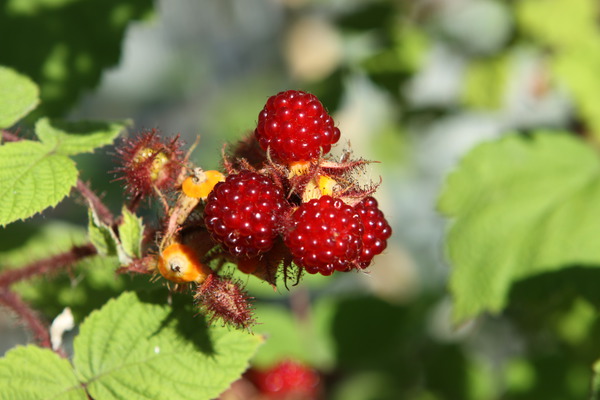
Picture: fruits of japanese wineberry
Crosses between blackberries and raspberries
Since the end of the 19th century, efforts have repeatedly been made to cross raspberries with blackberries. Some of these varieties have also prevailed to this day. These varieties combine the best qualities of both origins. The growth behaviour is more like that of a blackberry, since no suckers are formed. In addition, the fruits, like the blackberries, remain attached to the receptacle and they have the size as a blackberry or are even significantly larger. In addition, there have a much earlier maturity, which is roughly the same time as the middle to late summer raspberries.
Buckingham Tayberry® is a thornless variant of the well-known Tayberry and goes back to a Scottish breeding. This robust and vigorous growing variety produces very large, dark red fruits. The fruits are extremely aromatic and pleasantly sweet and sour. The ripening period starts around mid/end of June.
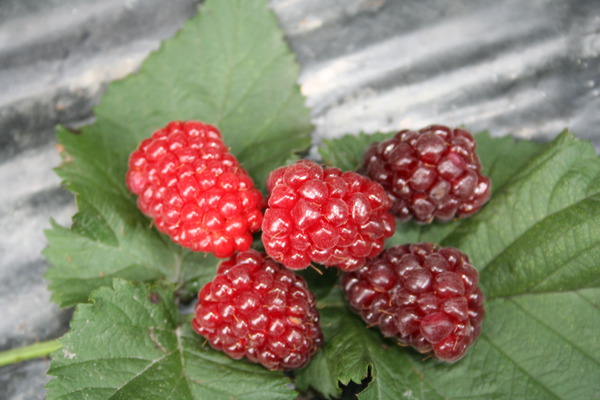
Picture: thornless tayberry variety Buckingham Tayberry®
Tayberry is a variety that was bred in Scotland in the 1960s and it is identical to the variety 'Buckingham Tayberry' except for the thorned shoots.
Thornless Loganberry came on the market as a thornless variant of the hitherto thorny Loganberry in the 1930s. This is a vigorous growing variety with long, overhanging shoots. The fruits ripen early, from mid-June, and they are very large, tart and aromatic with a sweet and sour flavour.
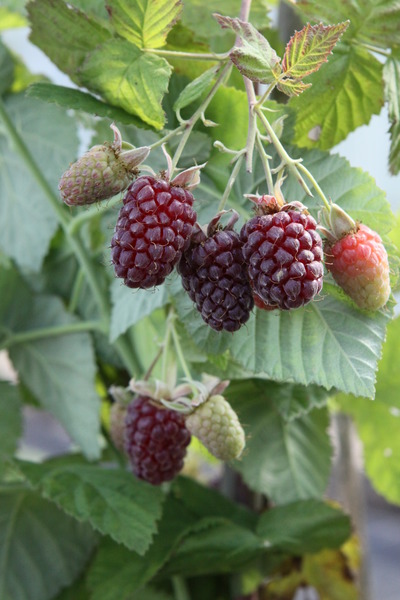
Picture: Rubus hybride Thornless Loganberry
Thornless Boysenberry originated in California at the beginning of the 20th century. The very large fruits are the darkest of all blackberry-raspberry hybrids. The dark, brown-red fruits are not shiny, unlike the classic blackberries. This thornless variety has moderate growth and is extremely robust.
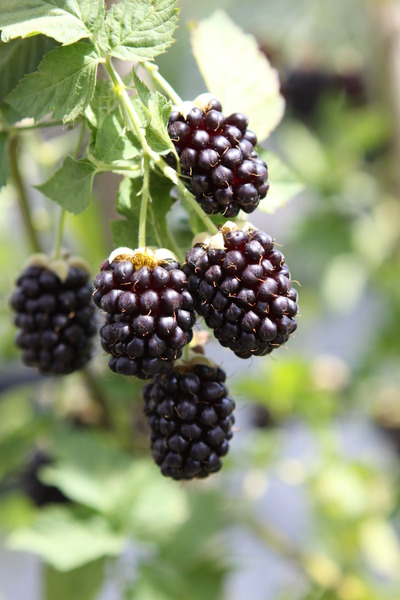
Picture: Rubus hybride Thornless Boysenberry
Dorman Red is basically not a blackberry-raspberry hybrid but a cross between an Australian wild raspberry (Rubus parvifolius) and a normal raspberry. This variety is still worth mentioning since its growth behaviour is very reminiscent of a blackberry or blackberry-raspberry hybrid. Dorman Red has vigorous growth with long shoots and dark foliage. The medium-sized raspberry fruits are very attractive and bright red in colour.
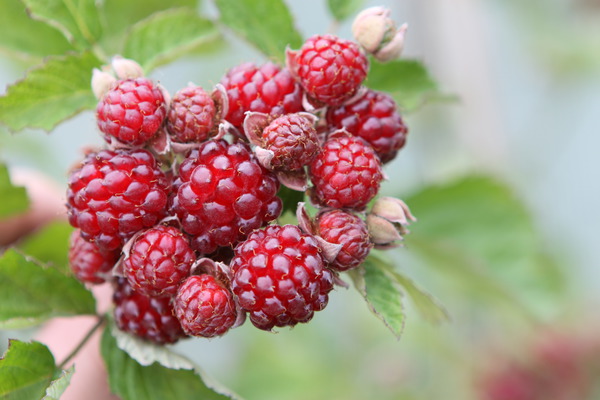
Picture: Rubus hybride Dorman Red
How do things continue with the blackberries?
Our sister company Lubera®, in collaboration with the breeding institute in East Malling (Southern England), runs its own blackberry breeding programme especially for the home garden market. This joint breeding programme, in the truest sense of the word, bears fruit for the first time this year: the young plants from the first crossings are starting to bear fruit. The goals are to improve the fruit size and the taste. This is to be achieved in the longer term by breeding other blackberry origins with more aromatic fruits into our current blackberry genetics (mostly using species that are native to the east coast of the United States). Furthermore, there is always a main emphasis on general plant health, especially on the winter hardiness of the canes. An earlier harvest of primocane blackberries (that bear fruit on new canes) is also in focus.
Another priority of blackberry breeding at Lubera is the optimisation and expansion of the compact varieties for growing in containers on balconies and terraces.
Click here for more information.
Would you like more information, an individual consultation or information about additional ranges?
Click here for the complete 2019 catalogue, which can be downloaded.
If you have specific questions, please do not hesitate to contact our customer service, where you can also spontaneously place an order.
And of course we are always there for you via telephone.
If you want to be regularly informed about news, etc., you can also subscribe to our gardener newsletter here, which we send out about once a month - it's worth it!
